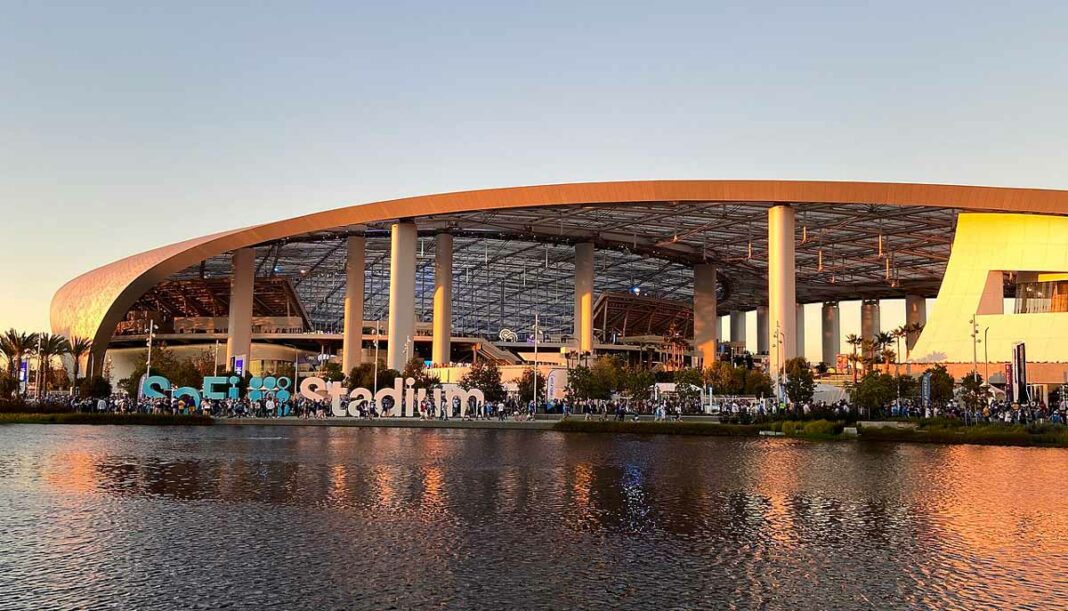Estimated reading time: 4 minutes
The Super Bowl returns to California on February 13th, 2022, with Super Bowl LVI kicking off at the SoFi Stadium, home of the Rams and Chargers. With regular TV audiences of over 100 million viewers, the game is once again, guaranteed to generate a huge amount of attention.
Last year around 23 million Americans wagered a total of $4.3 billion on the Super Bowl LV matchup between Tampa Bay Buccaneers and Kansas City Chiefs, and this season is shaping up to be too close to call according to the latest Super Bowl betting.
With such a huge, captive audience the NFL understands it has the ability to motivate and educate followers of the game. Which is why this year, more than any other, organisers are paying extra attention to going green and reducingthe environmental impact of the NFL.
Off the back of several devastating climate disasters in the US, ranging from Hurricanes, to flash flooding, droughts and wildfires, Football is eager to help and inspire as much as possible.
The league’s environmental program, NFL Green, was set up in 1993, with the aim of mitigating the environmental impact of the NFL’s major events. It also drives the creation of a “green” legacy in the communities that host the Super Bowl, Pro Bowl, and NFL Draft.
Their work has earnt the Super Bowl the accolade of the greenest professional sports event in America. But how exactly have they done it?
Food Recovery
Partnering with local food banks and event managers, NFL Green recover unserved food, packaged snacks and beverages from stadiums after the game. These are then donated to help feed those most in need within the community. To give some idea of the quantities involved, Super Bowl events can generate up to 140,000 pounds of donatable products.
in 2019, over 500,000 fans attended Super Bowl events in Atlanta. Local food banks and non-profits recovered over 60,000 pounds of food, and 77,000 pounds of beverages. A similar amount was rescued in 2018, in Minneapolis.
Recycling
It’s not just excess food that can be recovered from stadiums after games, thousands of fans use a variety of beverage and food containers that can be recycled. Working closely with each stadium, NFL Green initiates fan engagement at games, encouraging them to recycle as much as possible.
The aim is to divert as much waste as possible from landfill and to recycle and compost as much spectator waste as possible. The hope is that fans will be encouraged to do the same at home.
Super Bowl E-Waste Recycling Rally
Working alongside NFL Sponsor Verizon, NFL Green support the responsible recycling of E-Waste. Every year, a one-day E-Waste event is hosted in partnership with the local zoo just before Super Bowl. E-Waste recycling collects valuable materials from old electronic items that people no longer use or need. By recycling these precious minerals and metals, it helps to reduce the need for mining and prevents potentially toxic materials heading to landfill.
Super Kids-Super Sharing
This is a Super Bowl project that puts much needed books, sports equipment, school supplies and games in the hands of local children. The project, which is called Super Kids-Super Sharing, has run in every Super Bowl host community for over 20 years.
Since its inception in 2000 at Super Bowl XXXIV in Atlanta, theproject has encouraged children and families to repurpose items they no longer want and pass them along to others who can benefit. Hundreds of thousands of items have been repurposed, re-used and saved from landfill since the programme started.
Community Greening
NFL Green has developed an array of initiativesfocused on community greening and social justice. These includegiving fresh food access to low-income communities known as ‘food deserts’,to tree planting, community and pollinator gardens, plus native habitat restoration.
Funding for the greening projects comes from sponsors and by working closely with local community organizations and parks and recreation departments. Last year’s Super Bowl in Florida saw coral reef restoration efforts, the removal of 1.5 tons of underwater waste and mangrove planting as part of the project.
Material Donation
Games produce significant amounts of materials such as building materials, office supplies, carpets, decorations etc. Thanks to NFL Green, community partners help recover and redistribute any items that are still usable, donating them to local non-profit groups and stopping them from entering landfill.
Super Bowl 2022
The hugely impressive SoFi stadium, home of this year’s Super Bowl, is not only an aesthetically pleasing structure, but is also designed to have a lower carbon footprint than much smaller buildings. That ability is thanks in part to it’s clever cooling system that utilises collected rainwater which it stores in man-made lakes, negating the need for energy hungry heat pumps.
Fans at Super Bowl LVI will be encouraged to recycle responsibly, while all food and beverage containers in the stadium will be biodegradable, PFA-free, compostable, and recyclable. The local Greening Program has already started with tree and flower planting in Inglewood’s Edward Vincent Park just the beginning.
Despite all this great work, there is still much more to be done to reduce the carbon footprint of the NFL, including transport issues to stadiums with their vast, concrete car parks. But thanks to NFL Green, reducing the environmental impact of hosting these huge events continues to be a priority.






















